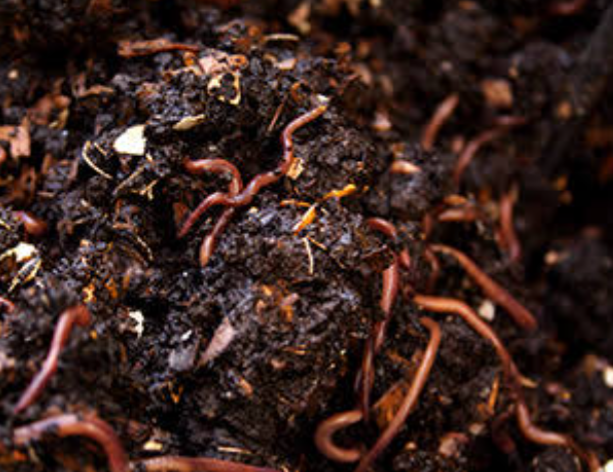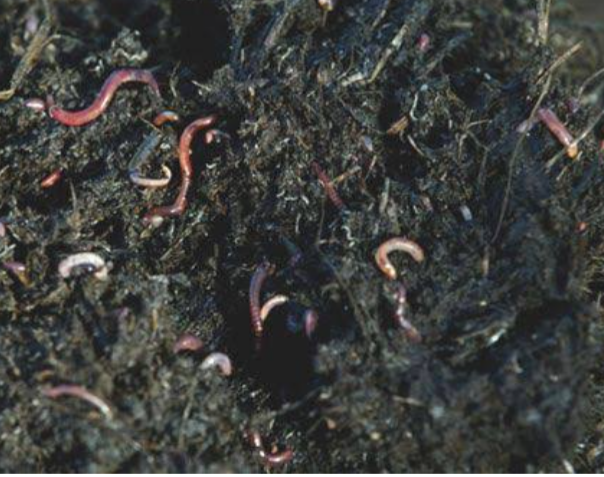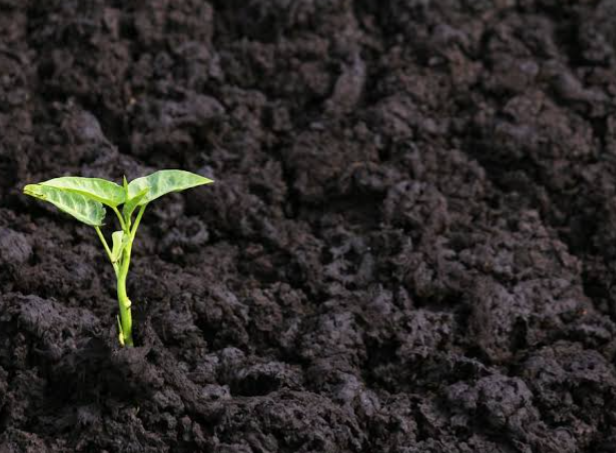
The organic matter in the soil is derived from plants and animals. In a forest for example, leaf litters and woody materials fall to the forest floor. This is referred to as ORGANIC MATERIALS. When it decays to the point in which it is no longer recognizable, the organic material is then called SOIL ORGANIC MATTER. When the organic matter is broken down into a stable humic substances that resist further decomposition, it is then called HUMUS. Thus, soil organic matter comprises of all the organic matter in the soil exclusive of the materials that have not decomposed.
Soil organic matter is any materials produced originally by living organisms (plants and animals) that is returned to the soil and goes through decomposition process. At any given time, it consist of a range of materials from the intact original tissues of plants and animals to the substantially decomposed mixture of materials known as humus.
Soil organic matter is composed of a variety of components. These include: in varying proportion and many intermediate stages, an active organic fractions including micro organisms ( 10 to 40 percent), and resistant or stable organic matter ( 40 to 60 percent) also referred to as humus (FAO 2005)
Organic matter may be divided into above ground fractions and below ground fractions.
Above ground organic matter comprises of plant residues and animal reminds. While below ground fractions comprises of living soil fauna and microflora, partially decomposed plants and animal residues and humic substances.
PRACTICES THAT DECREASES SOIL ORGANIC MATTER
Various types of human activities decreases soil organic matter content. However, increasing organic matter content of the soil or even maintaining good level requires a sustained effort that include: returning organic matter to the soil, rotations with high residue crops, and deep or dense rooting crops.
Management practices that alter the living organisms and nutrient condition of the soil such as repetitive tillage or burning of vegetation, result in degradation of the soil microenvironment. Which in turn result in a reduction of soil biota both in biomass and diversity. When there are no longer organisms to decompose soil organic materials to produce organic matter that bind soil particles together, soil structure is destroyed
The factors leading to decrease in soil organic matter are
1. DECREASE IN BIOMASS PRODUCTION
a) Replacement of perennial vegetation: When forest are cleared for Agricultural purposes, litter layers also dissappear and this causes a reduction in the number and varieties of soil organisms. The dissapearance of the litter layer and microbs result in low soil organic matter.
b) High harvesting index: One of the consequences of the green revolution was the replacement of indigenous varieties of crop species with high yielding varieties. The high yielding varieties produces more grains and less straws compared to indigenous varieties. If the harvest index of the crop (ratio of grains to total plant mass above ground) is high, then the quantity of shoot will not be sufficient to produce organic matter. Therefore, after harvest, there is reduced amount of crop residue for soil cover and organic matter or for grazing of livestock (which result in manure production).
c) Replacement of mixed vegetation with Monoculture of crops and pasture: In monocropping production system, where a single crop is grown, the root system of the crop can be extensive and explore vast area of soil. The root exudates from that single crop will attract only a few different microbial species. This in turn will affect the predatory diversity. The more opportunistic pathogens species will be able to aquire space near the crop and cause harm. Continuous cultivation and grazing also leads to compaction of soil layers, which inturn affect the circulation of air. Anaerobic condition in the soil stimulate the growth of different micro organisms, resulting in more pathogenic organisms.
2. DECREASE IN ORGANIC MATTER SUPPLY
a) Burning of natural vegetation and crop residue:
Burning of crop residue is normally done to control insect pest or diseases or to make field clearing easier. Burning destroys the litter layer and organisms inhibiting the surface soil and so diminishes the amount of organic matter returned to the soil. For DECOMPOSITION of the litters to take place, energy has to be invested in rebuilding the microbial community before plant nutrients can be released.
b) Overgrazing: overgrazing by cattle and other ruminants result in disappearance of most palatable and useful plant species and reduce the density of plant cover, thereby increasing the erosion hazards and reducing the nutritional values and carrying capacity of the land.
c) Removal of crop reaidue: Crop residues are removed by farmers to feed animals, make bedding or to make compost. The residue are latter returned to the soil through animal dung to contribute to soil fertility. Atimes, the residues are removed and not returned back to the soil. This decrease the amount of organic matter in the soil.
3. INCREASE DECOMPOSITION RATE
a) Tillage : Tillage makes the soil to be aerated. Oxygen stimulate or speed activities of soil micro organisms. When the soil is ploughed and residues incorporated into the soil, micro organisms act on the residues and the rate of decomposition becomes faster. This result in formation of less stable humus and an increase carbon dioxide liberation to the atmosphere and thus a reduction in organic matter.
b) Drainage: Decomposition of organic matter occurs more slowly in poorly aerated soil where oxygen is limiting or absent compared with well aerated soils. For this reasons, more organic materials accumulate in wet soil environment than organic matter. Soil drainage is determined strongly by soil in depression at the bottom of hills which tend to remain wet for some period of time because they receive water from up slope. Soils may also have a layer in the subsoil that inhibit drainage against exacebating water logging and reduction in organic matter decomposition.
One of the major structural part of plant, lignin, does not decompose at all. Plants residues with lignin result in reduction of the amount of organic matter in the soil.
The Ultimate consequence of extremely wet or swampy conditions is the development of organic soil with organic matter content of more than 30%. Where Soils are drained artificially for Agricultural or other uses, the soil becomes aerated and the organic matter decompose rapidly.
c) Fertilisers and pesticides uses: The use of fertilisers and pesticides enhances crop development and thus, production of biomass. However, the use of some fertilisers especially nitrogen fertilisers and pesticides can boost micro organisms activities and thus decomposition of organic matter. The chemicals provide the micro organism with easy to use nitrogen components. This is especially important when the C:N ratio of the soil organic matter is high, the lack of nitrogen will slow down decomposition rate
MAINTENANCE OF SOIL ORGANIC MATTER

It is much more difficult to maintain the organic matter content at satisfactory level. Farmers have developed practical methods of conservation
1. CROP RESIDUE MANAGEMENT : CROP residue made up of stalks, leaves, roots and stubble may be ploughed back into the soil or left on the soil surface to decompose. The rate of decomposition is higher when the residue is worked into the soil that is well aerated . The roots particularly of cereals like sorghum, millet, and maize make a significant contribution to soil organic matter when they decompose.
2. GREEN MANURING : Legumes enrich the soil with nitrogen. Therefore, crop yield are greater when rotated with legumes. Legumes can be cultivated for harvesting or as green manure crop. Legume should be ploughed back into the soil when it is still relatively immature, green and succulent. This practice increases the humus content of the soil and markedly raise the level of nitrogen. It is particularly beneficial for sandy soil low in organic matter where any nitrogen fertiliser applied is easily leached away together with other nutrients. Green manure also protect the soil from erosion. The rate of microbial activities is determined largely by the level of soil humus and so increase after green manuring.
A good green manuring crop should grow rapidly, producing abundant succulent tops, should be hardy, and should grow reasonably well on poor soil. The mucuna species, soybeans and cowpea are suitable green manure crops. Several varieties of millet may be suitable for savanna zones but this would require addition of nitrogen to raise the C:N ratio and avoid net immobilisation.
In the humid and seasonally dry savanna, green manuring is not very useful because the cropping/rainfall season is relatively short and planting a green manure crop would mean the loss of a year’s economic crop.

3. ORGANIC MANURE: Next to bush fallowing, the use of farm yard manure on arable land is the best known traditional method of sustaining soil fertility and productivity in the tropics, particularly in Africa. The chief source of animal manure are goats, sheep and cattle. Wide spread use of farm yard manure is however limited by its availability. Cattle rearing is largely nomadic or semi nomadic and until fairly recently, was little integrated with arable farming. In recent part of Africa, the soil is manured when cattle are penned on crop lands or when goats and /or sheep are allowed to feed on crop residue. Because of the huge amount of farm yard manure needed per unit of land, it is hardly ever available in sufficient quantity and transportation is difficult in view of its bulkiness
4. COMPOSTING: A major disadvantage of adding large quantity of fresh plant material such as crop residue to the soil is the high C:N ratio of these organic residue. Undecomposed plant matter has a C:N ratio of more than 20:1 and when added to the soil in large amount, net immobilisation of nitrogen result.
The C:N ratio of compost is first reduced by partial decomposition under well aerated condition. The rottened materials are then incorporated into the soil. Addition of fertilisers into the compost help to improve the rate of decomposition and the ultimate quality. Like farm yard manure, the use of compost is limited by labour cost but in terms of preparation and transportation, often now, its use is restricted to high value vegetable crops.
5. FERTILISER APPLICATION: The use of mineral fertilisers has an indirect effect on soil organic matter by boosting crop growth. The crop will produce a lot of shoot parts which produces considerable amount of residue. The residue in turn produces high amount of organic matter. The use of fertiliser in conjuction with farm yard manure increases the efficiency of crop plant.
When cereal crop like millet, maize and sorghum are fertilised, they leave behind considerable amount of organic residue in the form of roots and stumps even if the stalk are removed from the field, such root materials do not decompose rapidly owing to their wide C:N ratio. Where a cereal – legume rotation is adopted, the organic residue undergoes rapid microbial decay to produce humus due to the high amount of nitrogen fixed by the legume.
WAYS OF INCREASING ORGANIC MATTER CONTENT OF THE SOIL
1. COMPOST: Compost contain organic matter that has undergone decomposition to form a biologically stable humic substances. It is very similar in composition to soil organic matter. It breaks down slowly in the soil and it is very good at improving the physical condition of the soil. Composting can complement certain crop rotation and agro forestry system. It can be used efficiently in planting crops and in nurseries.
2. ZERO OR REDUCED TILLAGE: Repetitive tillage degrades the soil structure and its potential to hold moisture, reduces the amount of organic matter in the soil, break up aggregates and reduces the population of soil fauna such as earthworm that contribute to nutrient cycling and soil structure.
Tillage is one of the major practices that reduces the organic matter level in the soil. Each time soil is tilled, it is aerated. Oxygen stimulate or speed up action of soil micro organisms which feed on organic matter, that is, increase mineralization.
The term zero tillage is used for a practice whereby mechanical soil disturbance is avoided. Reduced or zero tillage regulate heterotrophic microbiological activities because the pore atmosphere is rich in carbon dioxide/oxygen and facilitate the activities of the humifiers.
3. PERENNIAL FORAGE CROPS: CROP residues have many uses. It can be used for fodder, roofing etc. When residues are removed and not returned to the soil, the amount of organic matter in the soil is reduced. When residues are removed and feed to animals for example, organic matter is lost if animal manure is not returned to the soil. By controlled grazing, the animal manure can be returned to the field.
4.. AGRO FORESTRY : This is a land use system where woody perennials ( trees and shrubs) are integrated into the farming system. The leaves and stem of trees falls to the forest floor and decay. They decay to form humic substances which add to the soil organic matter. Prunning of trees and shrubs during the cropping season provide green manure.
5. COVER CROPS/ GREEN MANURE CROPS: Growing cover crops is one of the best practices for improving organic matter level of the soil. Some benefits of cover crops are :
a) they prevent erosion by anchoring soil and lessening the impact of raindrops
b) they moderate soil temperature and hence protect soil organisms
c) legume species fix nitrogen in the soil for future use
d) Addition of plant materials to the soil replenishes organic matter
e) they bind excess nutrients in the soil and prevent leaching
Green manure plants or plant materials are grown solely for the purpose of incorporating them into the soil. When cover crops such as legumes are used in rotation, the legumes fix nitrogen, their leaves protect the soil erosion and high temperature incidence and their residues decompose rapidly because of their low C:N ratio. This helps increase the organic matter content of the soil.
TERMINOLOGIES
HUMIC SUBSTANCES: Humic substances refer to products resulting from the decomposition of plant and animal residues.
C:N RATIO: Carbon to Nitrogen ratio. If the C:N ratio is high, this means the carbon level is higher than the nitrogen level. But when the C:N level is low, the nitrogen content is higher than the carbon level.
FODDER: food, especially dried hay or straw, for cattle and other livestock.
FORAGE: Forages are plants or parts of plants eaten by livestock (cows, horses, sheep, goats,)
